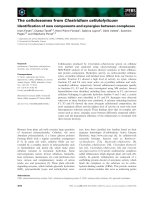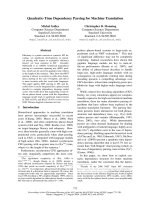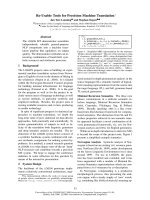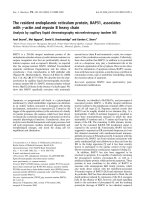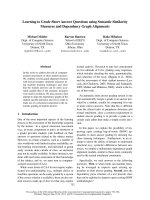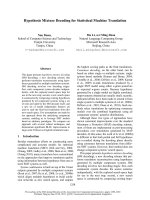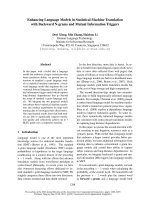Báo cáo khoa học: "Enhancing Language Models in Statistical Machine Translation with Backward N-grams and Mutual Information Triggers" ppt
Bạn đang xem bản rút gọn của tài liệu. Xem và tải ngay bản đầy đủ của tài liệu tại đây (653.9 KB, 10 trang )
Proceedings of the 49th Annual Meeting of the Association for Computational Linguistics, pages 1288–1297,
Portland, Oregon, June 19-24, 2011.
c
2011 Association for Computational Linguistics
Enhancing Language Models in Statistical Machine Translation
with Backward N-grams and Mutual Information Triggers
Deyi Xiong, Min Zhang, Haizhou Li
Human Language Technology
Institute for Infocomm Research
1 Fusionopolis Way, #21-01 Connexis, Singapore 138632
{dyxiong, mzhang, hli}@i2r.a-star.edu.sg
Abstract
In this paper, with a belief that a language
model that embraces a larger context provides
better prediction ability, we present two ex-
tensions to standard n-gram language mod-
els in statistical machine translation: a back-
ward language model that augments the con-
ventional forward language model, and a mu-
tual information trigger model which captures
long-distance dependencies that go beyond
the scope of standard n-gram language mod-
els. We integrate the two proposed models
into phrase-based statistical machine transla-
tion and conduct experiments on large-scale
training data to investigate their effectiveness.
Our experimental results show that both mod-
els are able to significantly improve transla-
tion quality and collectively achieve up to 1
BLEU point over a competitive baseline.
1 Introduction
Language model is one of the most important
knowledge sources for statistical machine transla-
tion (SMT) (Brown et al., 1993). The standard
n-gram language model (Goodman, 2001) assigns
probabilities to hypotheses in the target language
conditioning on a context history of the preceding
n − 1 words. Along with the efforts that advance
translation models from word-based paradigm to
syntax-based philosophy, in recent years we have
also witnessed increasing efforts dedicated to ex-
tend standard n-gram language models for SMT. We
roughly categorize these efforts into two directions:
data-volume-oriented and data-depth-oriented.
In the first direction, more data is better. In or-
der to benefit from monolingual corpora (LDC news
data or news data collected from web pages) that
consist of billions or even trillions of English words,
huge language models are built in a distributed man-
ner (Zhang et al., 2006; Brants et al., 2007). Such
language models yield better translation results but
at the cost of huge storage and high computation.
The second direction digs deeply into monolin-
gual data to build linguistically-informed language
models. For example, Charniak et al. (2003) present
a syntax-based language model for machine transla-
tion which is trained on syntactic parse trees. Again,
Shen et al. (2008) explore a dependency language
model to improve translation quality. To some ex-
tent, these syntactically-informed language models
are consistent with syntax-based translation models
in capturing long-distance dependencies.
In this paper, we pursue the second direction with-
out resorting to any linguistic resources such as a
syntactic parser. With a belief that a language model
that embraces a larger context provides better pre-
diction ability, we learn additional information from
training data to enhance conventional n-gram lan-
guage models and extend their ability to capture
richer contexts and long-distance dependencies. In
particular, we integrate backward n-grams and mu-
tual information (MI) triggers into language models
in SMT.
In conventional n-gram language models, we look
at the preceding n − 1 words when calculating the
probability of the current word. We henceforth call
the previous n − 1 words plus the current word
as forward n-grams and a language model built
1288
on forward n-grams as forward n-gram language
model. Similarly, backward n-grams refer to the
succeeding n − 1 words plus the current word. We
train a backward n-gram language model on back-
ward n-grams and integrate the forward and back-
ward language models together into the decoder. In
doing so, we attempt to capture both the preceding
and succeeding contexts of the current word.
Different from the backward n-gram language
model, the MI trigger model still looks at previous
contexts, which however go beyond the scope of for-
ward n-grams. If the current word is indexed as w
i
,
the farthest word that the forward n-gram includes
is w
i−n+1
. However, the MI triggers are capable of
detecting dependencies between w
i
and words from
w
1
to w
i−n
. By these triggers ({w
k
→ w
i
}, 1 ≤
k ≤ i −n), we can capture long-distance dependen-
cies that are outside the scope of forward n-grams.
We integrate the proposed backward language
model and the MI trigger model into a state-of-
the-art phrase-based SMT system. We evaluate
the effectiveness of both models on Chinese-to-
English translation tasks with large-scale training
data. Compared with the baseline which only uses
the forward language model, our experimental re-
sults show that the additional backward language
model is able to gain about 0.5 BLEU points, while
the MI trigger model gains about 0.4 BLEU points.
When both models are integrated into the decoder,
they collectively improve the performance by up to
1 BLEU point.
The paper is structured as follows. In Section 2,
we will briefly introduce related work and show how
our models differ from previous work. Section 3 and
4 will elaborate the backward language model and
the MI trigger model respectively in more detail, de-
scribe the training procedures and explain how the
models are integrated into the phrase-based decoder.
Section 5 will empirically evaluate the effectiveness
of these two models. Section 6 will conduct an in-
depth analysis. In the end, we conclude in Section
7.
2 Related Work
Previous work devoted to improving language mod-
els in SMT mostly focus on two categories as we
mentioned before
1
: large language models (Zhang
et al., 2006; Emami et al., 2007; Brants et al., 2007;
Talbot and Osborne, 2007) and syntax-based lan-
guage models (Charniak et al., 2003; Shen et al.,
2008; Post and Gildea, 2008). Since our philoso-
phy is fundamentally different from them in that we
build contextually-informed language models by us-
ing backward n-grams and MI triggers, we discuss
previous work that explore these two techniques
(backward n-grams and MI triggers) in this section.
Since the context “history” in the backward lan-
guage model (BLM) is actually the future words
to be generated, BLM is normally used in a post-
processing where all words have already been gener-
ated or in a scenario where sentences are proceeded
from the ending to the beginning. Duchateau et al.
(2002) use the BLM score as a confidence measure
to detect wrongly recognized words in speech recog-
nition. Finch and Sumita (2009) use the BLM in
their reverse translation decoder where source sen-
tences are proceeded from the ending to the begin-
ning. Our BLM is different from theirs in that we ac-
cess the BLM during decoding (rather than after de-
coding) where source sentences are still proceeded
from the beginning to the ending.
Rosenfeld et al. (1994) introduce trigger pairs
into a maximum entropy based language model as
features. The trigger pairs are selected accord-
ing to their mutual information. Zhou (2004) also
propose an enhanced language model (MI-Ngram)
which consists of a standard forward n-gram lan-
guage model and an MI trigger model. The latter
model measures the mutual information of distance-
dependent trigger pairs. Our MI trigger model is
mostly inspired by the work of these two papers, es-
pecially by Zhou’s MI-Ngram model (2004). The
difference is that our model is distance-independent
and, of course, we are interested in an SMT problem
rather than a speech recognition one.
Raybaud et al. (2009) use MI triggers in their con-
fidence measures to assess the quality of translation
results after decoding. Our method is different from
theirs in the MI calculation and trigger pair selec-
tion. Mauser et al. (2009) propose bilingual triggers
where two source words trigger one target word to
1
Language model adaptation is not very related to our work
so we ignore it.
1289
improve lexical choice of target words. Our analysis
(Section 6) show that our monolingual triggers can
also help in the selection of target words.
3 Backward Language Model
Given a sequence of words w
m
1
= (w
1
w
m
), a
standard forward n-gram language model assigns a
probability P
f
(w
m
1
) to w
m
1
as follows.
P
f
(w
m
1
) =
m
i=1
P (w
i
|w
i−1
1
) ≈
m
i=1
P (w
i
|w
i−1
i−n+1
) (1)
where the approximation is based on the nth order
Markov assumption. In other words, when we pre-
dict the current word w
i
, we only consider the pre-
ceding n − 1 words w
i−n+1
w
i−1
instead of the
whole context history w
1
w
i−1
.
Different from the forward n-gram language
model, the backward n-gram language model as-
signs a probability P
b
(w
m
1
) to w
m
1
by looking at the
succeeding context according to
P
b
(w
m
1
) =
m
i=1
P (w
i
|w
m
i+1
) ≈
m
i=1
P (w
i
|w
i+n−1
i+1
) (2)
3.1 Training
For the convenience of training, we invert the or-
der in each sentence in the training data, i.e., from
the original order (w
1
w
m
) to the reverse order
(w
m
w
1
). In this way, we can use the same toolkit
that we use to train a forward n-gram language
model to train a backward n-gram language model
without any other changes. To be consistent with
training, we also need to reverse the order of trans-
lation hypotheses when we access the trained back-
ward language model
2
. Note that the Markov con-
text history of Eq. (2) is w
i+n−1
w
i+1
instead of
w
i+1
w
i+n−1
after we invert the order. The words
are the same but the order is completely reversed.
3.2 Decoding
In this section, we will present two algorithms
to integrate the backward n-gram language model
into two kinds of phrase-based decoders respec-
tively: 1) a CKY-style decoder that adopts bracket-
ing transduction grammar (BTG) (Wu, 1997; Xiong
2
This is different from the reverse decoding in (Finch and
Sumita, 2009) where source sentences are reversed in the order.
et al., 2006) and 2) a standard phrase-based decoder
(Koehn et al., 2003). Both decoders translate source
sentences from the beginning of a sentence to the
ending. Wu (1996) introduce a dynamic program-
ming algorithm to integrate a forward bigram lan-
guage model with inversion transduction grammar.
His algorithm is then adapted and extended for inte-
grating forward n-gram language models into syn-
chronous CFGs by Chiang (2007). Our algorithms
are different from theirs in two major aspects
1. The string input to the algorithms is in a reverse
order.
2. We adopt a different way to calculate language
model probabilities for partial hypotheses so
that we can utilize incomplete n-grams.
Before we introduce the integration algorithms,
we define three functions P, L, and R on strings (in
a reverse order) over the English terminal alphabet
T . The function P is defined as follows.
P(w
k
w
1
) = P(w
k
) P (w
k−n+2
|w
k
w
k−n+3
)
a
×
1≤i≤k−n+1
P (w
i
|w
i+n−1
w
i+1
)
b
(3)
This function consists of two parts:
• The first part (a) calculates incomplete n-gram
language model probabilities for word w
k
to
w
k−n+2
. That means, we calculate the uni-
gram probability for w
k
(P (w
k
)), bigram prob-
ability for w
k−1
(P (w
k−1
|w
k
)) and so on un-
til we take n −1-gram probability for w
k−n+2
(P (w
k−n+2
|w
k
w
k−n+3
)). This resembles
the way in which the forward language model
probability in the future cost is computed in
the standard phrase-based SMT (Koehn et al.,
2003).
• The second part (b) calculates complete n-
gram backward language model probabilities
for word w
k−n+1
to w
1
.
The function is different from Chiang’s p func-
tion in that his function p only calculates language
model probabilities for the complete n-grams. Since
1290
we calculate backward language model probabilities
during a beginning-to-ending (left-to-right) decod-
ing process, the succeeding context for the current
word is either yet to be generated or incomplete in
terms of n-grams. The P function enables us to
utilize incomplete succeeding contexts to approxi-
mately predict words. Once the succeeding con-
texts are complete, we can quickly update language
model probabilities in an efficient way in our algo-
rithms.
The other two functions L and R are defined as
follows
L(w
k
w
1
) =
w
k
w
k−n+2
, if k ≥ n
w
k
w
1
, otherwise
(4)
R(w
k
w
1
) =
w
n−1
w
1
, if k ≥ n
w
k
w
1
, otherwise
(5)
The Land Rfunction return the leftmost and right-
most n − 1 words from a string in a reverse order
respectively.
Following Chiang (2007), we describe our algo-
rithms in a deductive system. We firstly show the
algorithm
3
that integrates the backward language
model into a BTG-style decoder (Xiong et al., 2006)
in Figure 1. The item [A, i, j; l|r] indicates that a
BTG node A has been constructed spanning from i
to j on the source side with the leftmost|rightmost
n −1 words l|r on the target side. As mentioned be-
fore, all target strings assessed by the defined func-
tions (P, L, and R) are in an inverted order (de-
noted by e). We only display the backward lan-
guage model probability for each item, ignoring all
other scores such as phrase translation probabilities.
The Eq. (8) in Figure 1 shows how we calculate
the backward language model probability for the ax-
iom which applies a BTG lexicon rule to translate
a source phrase c into a target phrase e. The Eq.
(9) and (10) show how we update the backward lan-
guage model probabilities for two inference rules
which combine two neighboring blocks in a straight
and inverted order respectively. The fundamental
theories behind this update are
P(e
1
e
2
) = P(e
1
)P(e
2
)
P(R(e
2
)L(e
1
))
P(R(e
2
))P(L(e
1
))
(6)
3
It can also be easily adapted to integrate the forward n-
gram language model.
Function Value
e
1
a
1
a
2
a
3
e
2
b
1
b
2
b
3
R(e
2
) b
2
b
1
L(e
1
) a
3
a
2
P(R(e
2
)) P (b
2
)P (b
1
|b
2
)
P(L(e
1
)) P (a
3
)P (a
2
|a
3
)
P(e
1
) P (a
3
)P (a
2
|a
3
)P (a
1
|a
3
a
2
)
P(e
2
) P (b
3
)P (b
2
|b
3
)P (b
1
|b
3
b
2
)
P(R(e
2
)L(e
1
))
P (b
2
)P (b
1
|b
2
)
P (a
3
|b
2
b
1
)P (a
2
|b
1
a
3
)
P(e
1
e
2
)
P (b
3
)P (b
2
|b
3
)P (b
1
|b
3
b
2
)
P (a
3
|b
2
b
1
)P (a
2
|b
1
a
3
)P (a
1
|a
3
a
2
)
Table 1: Values of P, L, and R in a 3-gram example .
P(e
2
e
1
) = P(e
1
)P(e
2
)
P(R(e
1
)L(e
2
))
P(R(e
1
))P(L(e
2
))
(7)
Whenever two strings e
1
and e
2
are concatenated
in a straight or inverted order, we can reuse their
P values (P(e
1
) and P(e
2
)) in terms of dynamic
programming. Only the probabilities of boundary
words (e.g., R(e
2
)L(e
1
) in Eq. (6)) need to be re-
calculated since they have complete n-grams after
the concatenation. Table 1 shows values of P, L,
and R in a 3-gram example which helps to verify
Eq. (6). These two equations guarantee that our
algorithm can correctly compute the backward lan-
guage model probability of a sentence stepwise in a
dynamic programming framework.
4
The theoretical time complexity of this algorithm
is O(m
3
|T |
4(n−1)
) because in the update parts in
Eq. (6) and (7) both the numerator and denomina-
tor have up to 2(n−1) terminal symbols. This is the
same as the time complexity of Chiang’s language
model integration (Chiang, 2007).
Figure 2 shows the algorithm that integrates the
backward language model into a standard phrase-
based SMT (Koehn et al., 2003). V denotes a cover-
age vector which records source words translated so
far. The Eq. (11) shows how we update the back-
ward language model probability for a partial hy-
pothesis when it is extended into a longer hypothesis
by a target phrase translating an uncovered source
4
The start-of-sentence symbol ⟨s⟩and end-of-sentence sym-
bol ⟨/s⟩ can be easily added to update the final language model
probability when a translation hypothesis covering the whole
source sentence is completed.
1291
A → c/e
[A, i, j; L(e)|R(e)] : P(e)
(8)
A → [A
1
, A
2
] [A
1
, i, k; L(e
1
)|R(e
1
)] : P(e
1
) [A
2
, k + 1, j; L(e
2
)|R(e
2
)] : P(e
2
)
[A, i, j; L(e
1
e
2
)|R(e
1
e
2
)] : P(e
1
)P(e
2
)
P(R(e
2
)L(e
1
))
P(R(e
2
))P(L(e
1
))
(9)
A → ⟨A
1
, A
2
⟩ [A
1
, i, k; L(e
1
)|R(e
1
)] : P(e
1
) [A
2
, k + 1, j; L(e
2
)|R(e
2
)] : P(e
2
)
[A, i, j; L(e
2
e
1
)|R(e
2
e
1
)] : P(e
1
)P(e
2
)
P(R(e
1
)L(e
2
))
P(R(e
1
))P(L(e
2
))
(10)
Figure 1: Integrating the backward language model into a BTG-style decoder.
[V; L(e
1
)] : P(e
1
) c/e
2
: P(e
2
)
[V
′
; L(e
1
e
2
)] : P(e
1
)P(e
2
)
P(R(e
2
)L(e
1
))
P(R(e
2
))P(L(e
1
))
(11)
Figure 2: Integrating the backward language model into
a standard phrase-based decoder.
segment. This extension on the target side is simi-
lar to the monotone combination of Eq. (9) in that a
newly translated phrase is concatenated to an early
translated sequence.
4 MI Trigger Model
It is well-known that long-distance dependencies be-
tween words are very important for statistical lan-
guage modeling. However, n-gram language models
can only capture short-distance dependencies within
an n-word window. In order to model long-distance
dependencies, previous work such as (Rosenfeld et
al., 1994) and (Zhou, 2004) exploit trigger pairs. A
trigger pair is defined as an ordered 2-tuple (x, y )
where word x occurs in the preceding context of
word y. It can also be denoted in a more visual man-
ner as x → y with x being the trigger and y the
triggered word
5
.
We use pointwise mutual information (PMI)
(Church and Hanks, 1990) to measure the strength
of the association between x and y, which is defined
as follows
P MI(x, y) = log(
P (x, y)
P (x)P (y)
) (12)
5
In this paper, we require that word x and y occur in the
same sentence.
Zhou (2004) proposes a new language model en-
hanced with MI trigger pairs. In his model, the prob-
ability of a given sentence w
m
1
is approximated as
P (w
m
1
) ≈(
m
i=1
P (w
i
|w
i−1
i−n+1
))
×
m
i=n+1
i−n
k=1
exp(PM I(w
k
, w
i
, i −k − 1))
(13)
There are two components in his model. The first
component is still the standard n-gram language
model. The second one is the MI trigger model
which multiples all exponential PMI values for trig-
ger pairs where the current word is the triggered
word and all preceding words outside the n-gram
window of the current word are triggers. Note that
his MI trigger model is distance-dependent since
trigger pairs (w
k
, w
i
) are sensitive to their distance
i −k −1 (zero distance for adjacent words). There-
fore the distance between word x and word y should
be taken into account when calculating their PMI.
In this paper, for simplicity, we adopt a distance-
independent MI trigger model as follows
MI(w
m
1
) =
m
i=n+1
i−n
k=1
exp(PM I(w
k
, w
i
)) (14)
We integrate the MI trigger model into the log-
linear model of machine translation as an additional
knowledge source which complements the standard
n-gram language model in capturing long-distance
dependencies. By MERT (Och, 2003), we are even
able to tune the weight of the MI trigger model
against the weight of the standard n-gram language
model while Zhou (2004) sets equal weights for both
models.
1292
4.1 Training
We can use the maximum likelihood estimation
method to calculate PMI for each trigger pair by tak-
ing counts from training data. Let C(x, y) be the
co-occurrence count of the trigger pair (x, y ) in the
training data. The joint probability of (x, y) is cal-
culated as
P (x, y) =
C(x, y)
x,y
C( x, y)
(15)
The marginal probabilities of x and y can be de-
duced from the joint probability as follows
P (x) =
y
P (x, y) (16)
P (y) =
x
P (x, y) (17)
Since the number of distinct trigger pairs is
O(|T|
2
), the question is how to select valuable trig-
ger pairs. We select trigger pairs according to the
following three steps
1. The distance between x and y must not be less
than n −1. Suppose we use a 5-gram language
model and y = w
i
, then x ∈ {w
1
w
i−5
}.
2. C(x, y) > c. In all our experiments we set c =
10.
3. Finally, we only keep trigger pairs whose PMI
value is larger than 0. Trigger pairs whose PMI
value is less than 0 often contain stop words,
such as “the”, “a”. These stop words have very
large marginal probabilities due to their high
frequencies.
4.2 Decoding
The MI trigger model of Eq. (14) can be directly
integrated into the decoder. For the standard phrase-
based decoder (Koehn et al., 2003), whenever a par-
tial hypothesis is extended by a new target phrase,
we can quickly retrieve the pre-computed PMI value
for each trigger pair where the triggered word lo-
cates in the newly translated target phrase and the
trigger is outside the n-word window of the trig-
gered word. It’s a little more complicated to in-
tegrate the MI trigger model into the CKY-style
phrase-based decoder. But we still can handle it by
dynamic programming as follows
MI(e
1
e
2
) = MI(e
1
)MI(e
2
)MI(e
1
→ e
2
) (18)
where MI(e
1
→ e
2
) represents the PMI values in
which a word in e
1
triggers a word in e
2
. It is defined
as follows
MI(e
1
→ e
2
) =
w
i
∈e
2
w
k
∈e
1
i−k≥n
exp(PM I(w
k
, w
i
))
(19)
5 Experiments
In this section, we conduct large-scale experiments
on NIST Chinese-to-English translation tasks to
evaluate the effectiveness of the proposed backward
language model and MI trigger model in SMT. Our
experiments focus on the following two issues:
1. How much improvements can we achieve by
separately integrating the backward language
model and the MI trigger model into our
phrase-based SMT system?
2. Can we obtain a further improvement if we
jointly apply both models?
5.1 System Overview
Without loss of generality
6
, we evaluate our models
in a phrase-based SMT system which adapts brack-
eting transduction grammars to phrasal translation
(Xiong et al., 2006). The log-linear model of this
system can be formulated as
w(D) =M
T
(r
l
1 n
l
) · M
R
(r
m
1 n
m
)
λ
R
· P
fL
(e)
λ
fL
· exp(|e|)
λ
w
(20)
where D denotes a derivation, r
l
1 n
l
are the BTG
lexicon rules which translate source phrases to tar-
get phrases, and r
m
1 n
m
are the merging rules which
combine two neighboring blocks into a larger block
in a straight or inverted order. The translation
model M
T
consists of widely used phrase and lex-
ical translation probabilities (Koehn et al., 2003).
6
We have discussed how to integrate the backward language
model and the MI trigger model into the standard phrase-based
SMT system (Koehn et al., 2003) in Section 3.2 and 4.2 respec-
tively.
1293
The reordering model M
R
predicts the merging or-
der (straight or inverted) by using discriminative
contextual features (Xiong et al., 2006). P
fL
is the
standard forward n-gram language model.
If we simultaneously integrate both the backward
language model P
bL
and the MI trigger model M I
into the system, the new log-linear model will be
formulated as
w(D) =M
T
(r
l
1 n
l
) · M
R
(r
m
1 n
m
)
λ
R
· P
fL
(e)
λ
fL
· P
bL
(e)
λ
bL
· MI(e)
λ
MI
· exp(|e|)
λ
w
(21)
5.2 Experimental Setup
Our training corpora
7
consist of 96.9M Chinese
words and 109.5M English words in 3.8M sentence
pairs. We used all corpora to train our translation
model and smaller corpora without the United Na-
tions corpus to build a maximum entropy based re-
ordering model (Xiong et al., 2006).
To train our language models and MI trigger
model, we used the Xinhua section of the En-
glish Gigaword corpus (306 million words). Firstly,
we built a forward 5-gram language model using
the SRILM toolkit (Stolcke, 2002) with modified
Kneser-Ney smoothing. Then we trained a back-
ward 5-gram language model on the same monolin-
gual corpus in the way described in Section 3.1. Fi-
nally, we trained our MI trigger model still on this
corpus according to the method in Section 4.1. The
trained MI trigger model consists of 2.88M trigger
pairs.
We used the NIST MT03 evaluation test data as
the development set, and the NIST MT04, MT05 as
the test sets. We adopted the case-insensitive BLEU-
4 (Papineni et al., 2002) as the evaluation metric,
which uses the shortest reference sentence length for
the brevity penalty. Statistical significance in BLEU
differences is tested by paired bootstrap re-sampling
(Koehn, 2004).
5.3 Experimental Results
The experimental results on the two NIST test sets
are shown in Table 2. When we combine the back-
ward language model with the forward language
7
LDC2004E12, LDC2004T08, LDC2005T10,
LDC2003E14, LDC2002E18, LDC2005T06, LDC2003E07
and LDC2004T07.
Model MT-04 MT-05
Forward (Baseline) 35.67 34.41
Forward+Backward 36.16+ 34.97+
Forward+MI 36.00+ 34.85+
Forward+Backward+MI 36.76+ 35.12+
Table 2: BLEU-4 scores (%) on the two test sets for dif-
ferent language models and their combinations. +: better
than the baseline (p < 0.01).
model, we obtain 0.49 and 0.56 BLEU points over
the baseline on the MT-04 and MT-05 test set respec-
tively. Both improvements are statistically signifi-
cant (p < 0.01). The MI trigger model also achieves
statistically significant improvements of 0.33 and
0.44 BLEU points over the baseline on the MT-04
and MT-05 respectively.
When we integrate both the backward language
model and the MI trigger model into our system,
we obtain improvements of 1.09 and 0.71 BLEU
points over the single forward language model on
the MT-04 and MT-05 respectively. These improve-
ments are larger than those achieved by using only
one model (the backward language model or the MI
trigger model).
6 Analysis
In this section, we will study more details of the two
models by looking at the differences that they make
on translation hypotheses. These differences will
help us gain some insights into how the presented
models improve translation quality.
Table 3 shows an example from our test set. The
italic words in the hypothesis generated by using the
backward language model (F+B) exactly match the
reference. However, the italic words in the base-
line hypothesis fail to match the reference due to
the incorrect position of the word “decree” (法令).
We calculate the forward/backward language model
score (the logarithm of language model probability)
for the italic words in both the baseline and F+B hy-
pothesis according to the trained language models.
The difference in the forward language model score
is only 1.58, which may be offset by differences in
other features in the log-linear translation model. On
the other hand, the difference in the backward lan-
guage model score is 3.52. This larger difference
may guarantee that the hypothesis generated by F+B
1294
Source 北京 青年报 报导 , 北京 农业局 最
近 发出 一连串 的 防治 及 监督 法
令
Baseline Beijing Youth Daily reported that
Beijing Agricultural decree recently
issued a series of control and super-
vision
F+B Beijing Youth Daily reported that
Beijing Bureau of Agriculture re-
cently issued a series of prevention
and control laws
Reference Beijing Youth Daily reported that
Beijing Bureau of Agriculture re-
cently issued a series of preventative
and monitoring ordinances
Table 3: Translation example from the MT-04 test set,
comparing the baseline with the backward language
model. F+B: forward+backward language model .
is better enough to be selected as the best hypothe-
sis by the decoder. This suggests that the backward
language model is able to provide useful and dis-
criminative information which is complementary to
that given by the forward language model.
In Table 4, we present another example to show
how the MI trigger model improves translation qual-
ity. The major difference in hypotheses of this ex-
ample is the word choice between “is” and “was”.
The new system enhanced with the MI trigger model
(F+M) selects the former while the baseline selects
the latter. The forward language model score for the
baseline hypothesis is -26.41, which is higher than
the score of the F+M hypothesis -26.67. This could
be the reason why the baseline selects the word
“was” instead of “is”. As can be seen, there is an-
other “is” in the preceding context of the word “was”
in the baseline hypothesis. Unfortunately, this word
“is” is located just outside the scope of the preceding
5-gram context of “was”. The forward 5-gram lan-
guage model is hence not able to take it into account
when calculating the probability of “was”. However,
this is not a problem for the MI trigger model. Since
“is” and “was” rarely co-occur in the same sentence,
the PMI value of the trigger pair (is, was)
8
is -1.03
8
Since we remove all trigger pairs whose PMI value is neg-
ative, the PMI value of this pair (is, was) is set 0 in practice in
the decoder.
Source 自卫队 此行 之所以 引人瞩目 , 是
因为 它 并非 是 一个 孤立 的 事件
。
Baseline Self-Defense Force ’s trip is remark-
able , because it was not an isolated
incident .
F+M Self-Defense Force ’s trip is remark-
able , because it is not an isolated in-
cident .
Reference The Self-Defense Forces’ trip
arouses attention because it is not an
isolated incident.
Table 4: Translation example from the MT-04 test set,
comparing the baseline with the MI trigger model. Both
system outputs are not detokenized so that we can see
how language model scores are calculated. The un-
derlined words highlight the difference between the en-
hanced models and the baseline. F+M: forward language
model + MI trigger model.
while the PMI value of the trigger pair (is, is) is as
high as 0.32. Therefore our MI trigger model selects
“is” rather than “was”.
9
This example illustrates that
the MI trigger model is capable of selecting correct
words by using long-distance trigger pairs.
7 Conclusion
We have presented two models to enhance the abil-
ity of standard n-gram language models in captur-
ing richer contexts and long-distance dependencies
that go beyond the scope of forward n-gram win-
dows. The two models have been integrated into
the decoder and have shown to improve a state-of-
the-art phrase-based SMT system. The first model
is the backward language model which uses back-
ward n-grams to predict the current word. We in-
troduced algorithms that directly integrate the back-
ward language model into a CKY-style and a stan-
dard phrase-based decoder respectively. The sec-
ond model is the MI trigger model that incorporates
long-distance trigger pairs into language modeling.
Overall improvements are up to 1 BLEU point on
the NIST Chinese-to-English translation tasks with
large-scale training data. Further study of the two
9
The overall MI trigger model scores (the logarithm of Eq.
(14)) of the baseline hypothesis and the F+M hypothesis are
2.09 and 2.25 respectively.
1295
models indicates that backward n-grams and long-
distance triggers provide useful information to im-
prove translation quality.
In future work, we would like to integrate the
backward language model into a syntax-based sys-
tem in a way that is similar to the proposed algo-
rithm shown in Figure 1. We are also interested in
exploring more morphologically- or syntactically-
informed triggers. For example, a verb in the past
tense triggers another verb also in the past tense
rather than the present tense.
References
Thorsten Brants, Ashok C. Popat, Peng Xu, Franz J.
Och, and Jeffrey Dean. 2007. Large language mod-
els in machine translation. In Proceedings of the
2007 Joint Conference on Empirical Methods in Nat-
ural Language Processing and Computational Natu-
ral Language Learning (EMNLP-CoNLL), pages 858–
867, Prague, Czech Republic, June. Association for
Computational Linguistics.
P. F. Brown, S. A. Della Pietra, V. J. Della Pietra, and
R. L. Mercer. 1993. The mathematics of statistical
machine translation: Parameter estimation. Computa-
tional Linguistics, 19(2):263–311.
Eugene Charniak, Kevin Knight, and Kenji Yamada.
2003. Syntax-based language models for statistical
machine translation. In Proceedings of MT Summit IX.
Intl. Assoc. for Machine Translation.
David Chiang. 2007. Hierarchical phrase-based transla-
tion. Computational Linguistics, 33(2):201–228.
Kenneth Ward Church and Patrick Hanks. 1990. Word
association norms, mutual information, and lexicogra-
phy. Computational Linguistics, 16(1):22–29.
Jacques Duchateau, Kris Demuynck, and Patrick
Wambacq. 2002. Confidence scoring based on back-
ward language models. In Proceedings of ICASSP,
pages 221–224, Orlando, FL, April.
Ahmad Emami, Kishore Papineni, and Jeffrey Sorensen.
2007. Large-scale distributed language modeling. In
Proceedings of ICASSP, pages 37–40, Honolulu, HI,
April.
Andrew Finch and Eiichiro Sumita. 2009. Bidirectional
phrase-based statistical machine translation. In Pro-
ceedings of the 2009 Conference on Empirical Meth-
ods in Natural Language Processing, pages 1124–
1132, Singapore, August. Association for Computa-
tional Linguistics.
Joshua T. Goodman. 2001. A bit of progress in lan-
guage modeling extended version. Technical report,
Microsoft Research.
Philipp Koehn, Franz Joseph Och, and Daniel Marcu.
2003. Statistical phrase-based translation. In Proceed-
ings of the 2003 Human Language Technology Confer-
ence of the North American Chapter of the Association
for Computational Linguistics, pages 58–54, Edmon-
ton, Canada, May-June.
Philipp Koehn. 2004. Statistical significance tests for
machine translation evaluation. In Proceedings of
EMNLP 2004, pages 388–395, Barcelona, Spain, July.
Arne Mauser, Sa
ˇ
sa Hasan, and Hermann Ney. 2009. Ex-
tending statistical machine translation with discrimi-
native and trigger-based lexicon models. In Proceed-
ings of the 2009 Conference on Empirical Methods in
Natural Language Processing, pages 210–218, Singa-
pore, August. Association for Computational Linguis-
tics.
Franz Josef Och. 2003. Minimum error rate training in
statistical machine translation. In Proceedings of the
41st Annual Meeting of the Association for Compu-
tational Linguistics, pages 160–167, Sapporo, Japan,
July.
Kishore Papineni, Salim Roukos, Todd Ward, and Wei-
Jing Zhu. 2002. Bleu: a method for automatic eval-
uation of machine translation. In Proceedings of 40th
Annual Meeting of the Association for Computational
Linguistics, pages 311–318, Philadelphia, Pennsylva-
nia, USA, July.
Matt Post and Daniel Gildea. 2008. Parsers as language
models for statistical machine translation. In Proceed-
ings of AMTA.
Sylvain Raybaud, Caroline Lavecchia, David Langlois,
and Kamel Sma
¨
ıli. 2009. New confidence measures
for statistical machine translation. In Proceedings of
the International Conference on Agents and Artificial
Intelligence, pages 61–68, Porto, Portugal, January.
Roni Rosenfeld, Jaime Carbonell, and Alexander Rud-
nicky. 1994. Adaptive statistical language model-
ing: A maximum entropy approach. Technical report,
Carnegie Mellon University.
Libin Shen, Jinxi Xu, and Ralph Weischedel. 2008. A
new string-to-dependency machine translation algo-
rithm with a target dependency language model. In
Proceedings of ACL-08: HLT, pages 577–585, Colum-
bus, Ohio, June. Association for Computational Lin-
guistics.
Andreas Stolcke. 2002. Srilm–an extensible language
modeling toolkit. In Proceedings of the 7th Inter-
national Conference on Spoken Language Processing,
pages 901–904, Denver, Colorado, USA, September.
David Talbot and Miles Osborne. 2007. Randomised
language modelling for statistical machine translation.
In Proceedings of the 45th Annual Meeting of the Asso-
ciation of Computational Linguistics, pages 512–519,
1296
Prague, Czech Republic, June. Association for Com-
putational Linguistics.
Dekai Wu. 1996. A polynomial-time algorithm for sta-
tistical machine translation. In Proceedings of the 34th
Annual Meeting of the Association for Computational
Linguistics, pages 152–158, Santa Cruz, California,
USA, June.
Dekai Wu. 1997. Stochastic inversion transduction
grammars and bilingual parsing of parallel corpora.
Computational Linguistics, 23(3):377–403.
Deyi Xiong, Qun Liu, and Shouxun Lin. 2006. Maxi-
mum entropy based phrase reordering model for sta-
tistical machine translation. In Proceedings of the 21st
International Conference on Computational Linguis-
tics and 44th Annual Meeting of the Association for
Computational Linguistics, pages 521–528, Sydney,
Australia, July. Association for Computational Lin-
guistics.
Ying Zhang, Almut Silja Hildebrand, and Stephan Vogel.
2006. Distributed language modeling for n-best list
re-ranking. In Proceedings of the 2006 Conference on
Empirical Methods in Natural Language Processing,
pages 216–223, Sydney, Australia, July. Association
for Computational Linguistics.
GuoDong Zhou. 2004. Modeling of long distance con-
text dependency. In Proceedings of Coling, pages 92–
98, Geneva, Switzerland, Aug 23–Aug 27. COLING.
1297
